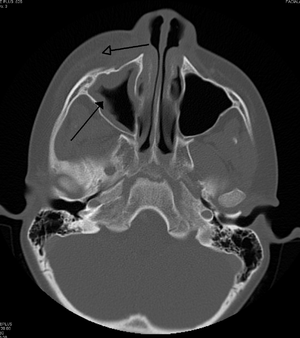Periorbital cellulitis
| Periorbital cellulitis | |
|---|---|
 | |
| Periorbital cellulitis caused by a dental infection (also causing maxillary sinusitis) | |
| Classification and external resources | |
| Specialty | dermatology |
| ICD-10 | H00.0, |
| ICD-9-CM | 373.13 |
| DiseasesDB | 31304 |
| MedlinePlus | 000976 |
| eMedicine | emerg/415 oph/206 |
Periorbital cellulitis, also known as preseptal cellulitis (and not to be confused with orbital cellulitis, which is behind the septum), is an inflammation and infection of the eyelid and portions of skin around the eye,[1] anterior to the orbital septum. It may be caused by breaks in the skin around the eye, and subsequent spread to the eyelid; infection of the sinuses around the nose (sinusitis); or from spread of an infection elsewhere through the blood.
Signs and symptoms
Periorbital cellulitis must be differentiated from orbital cellulitis, which is an emergency and requires intravenous (IV) antibiotics. In contrast to orbital cellulitis, patients with periorbital cellulitis do not have bulging of the eye (proptosis), limited eye movement (ophthalmoplegia), pain on eye movement, or loss of vision. If any of these features is present, one must assume that the patient has orbital cellulitis and begin treatment with IV antibiotics. CT scan may be done to delineate the extension of the infection.
Affected individuals may experience the following; swelling, redness, discharge, pain, shut eye, conjunctival injection, fever (mild), slightly blurred vision, teary eyes, and some reduction in vision.
Typical signs include periorbital erythema, induration, tenderness and warmth.[2]
Causes
Staphylococcus aureus, Streptococcus pneumoniae, other streptococci, and anaerobes are the most common causes, depending on the origin of the infection.[3]
The advent of the Haemophilus influenzae vaccine has dramatically decreased the incidence.[4]
Treatment
Antibiotics are aimed at gram positive bacteria. Warm to hot compresses help with pain and inflammation. Medical attention should be sought if symptoms persist beyond 2–3 days.
See also
References
- ↑ http://www.healthatoz.com/healthatoz/Atoz/common/standard/transform.jsp?requestURI=/healthatoz/Atoz/ency/orbital_and_periorbital_cellulitis.jsp
- ↑ Givner, Laurence B. (1 December 2002). "Periorbital versus orbital cellulitis". The Pediatric Infectious Disease Journal. 21 (12): 1157–1158. doi:10.1097/00006454-200212000-00014. PMID 12488668.
- ↑ Botting, A.M.; McIntosh, D.; Mahadevan, M. "Paediatric pre- and post-septal peri-orbital infections are different diseases". International Journal of Pediatric Otorhinolaryngology. 72 (3): 377–383. doi:10.1016/j.ijporl.2007.11.013.
- ↑ Donahue S, Schwartz G (1998). "Preseptal and orbital cellulitis in childhood. A changing microbiologic spectrum". Ophthalmology. 105 (10): 1902–5; discussion 1905–6. doi:10.1016/S0161-6420(98)91038-7. PMID 9787362.